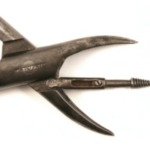History of Dental Instruments
July 11, 2016 2:41 pmAt Henson Family Dental, we pride ourselves on providing a modern, comfortable dental experience. We know some folks have a fear of the dentist, but we want to do everything we can to ease those fears. Sometimes, that means taking a peek under the hood of history to see how far dentistry has come!
Medical Instruments in general have come a long, long way in just a few years. Dental instruments have especially come a long way due to their intended purpose, being an instrument to assist a dentist in a particularly germy area of the body; the mouth. We have gone from archaic and unsanitary to modern and sterile in only a matter of two lifetimes. This progression is really quite fascinating when you truly examine it.
While there have been numerous progressive areas in dental instruments, it is still important to reflect upon the past occasionally to learn from it. Some of these (sometimes scary) dental instruments below range from mildly gross to downright spooky.
Bow Drill (7000 BC)

The Bow Drill has extensive history in what is now, geographically, Pakistan and India. The similarities between bow drills and and the bow drills to create fires, are strikingly similar. With the spinning/drilling motion, one was able to somewhat successfully drill teeth to correct issues within the teeth.
Dental Pelican (1600s)

Dental Pelicans closely resemble a pelican’s beak, hence the name. This tool was used from the 14th century to the late, 18th century. The lessening of its use is attributed to the introduction of dental keys.
Oral Speculum (1600s)

The Oral Speculum was used to open the mouth and hold it open for extended periods of time during a dental procedure. The essential function of the Oral Speculum resembles a reversed vice and functions just as such.
Goat’s Foot Extractor (1700s)

The goat’s foot elevator resembles a goat’s cleft foot, with its dual-pointed tip and hooking mechanism. The most commonly used tool in conjunction with the Goat’s Foot Extractor was the Dental Pelican.
Dental Key (1810s)

Dental Keys are another instrument that was inspired by, and subsequently transplanted to the dental industry from a different, unrelated industry: Locksmithing. The dental key was created based on the locking and rotating mechanism that a key uses.
Secateurs (1810s)

This orthodontic instrument from from France was widely used to throughout the world for removing infected or uneven teeth from a patient’s mouth. The mechanisms within the device would allow the dental professional to lock on to the tooth and remove it from the gum line.
Dental Screw Forceps (1850s)

The Dental Screw Forceps were an American invention that allowed the dentist to simultaneously drill while holding a tooth in place.
Figure-Rotated Dental Drill (1870s)

This delicate, yet powerful dental instrument, known as the “Finger-Rotated Dental Drill” brought things back to the basics with its organic motion and precision. It allowed dentists to successfully work at a much slower and defined pace to ensure that the force is as accurate as possible. This dental instrument led to the development of other, modern dental drills such as: hand crank drills, foot pedal drills, and finally, our modern day electric drills.
We hope this trip through dental history has been fascinating! Let us know your thoughts in the comments section, we’d love to hear from you!
